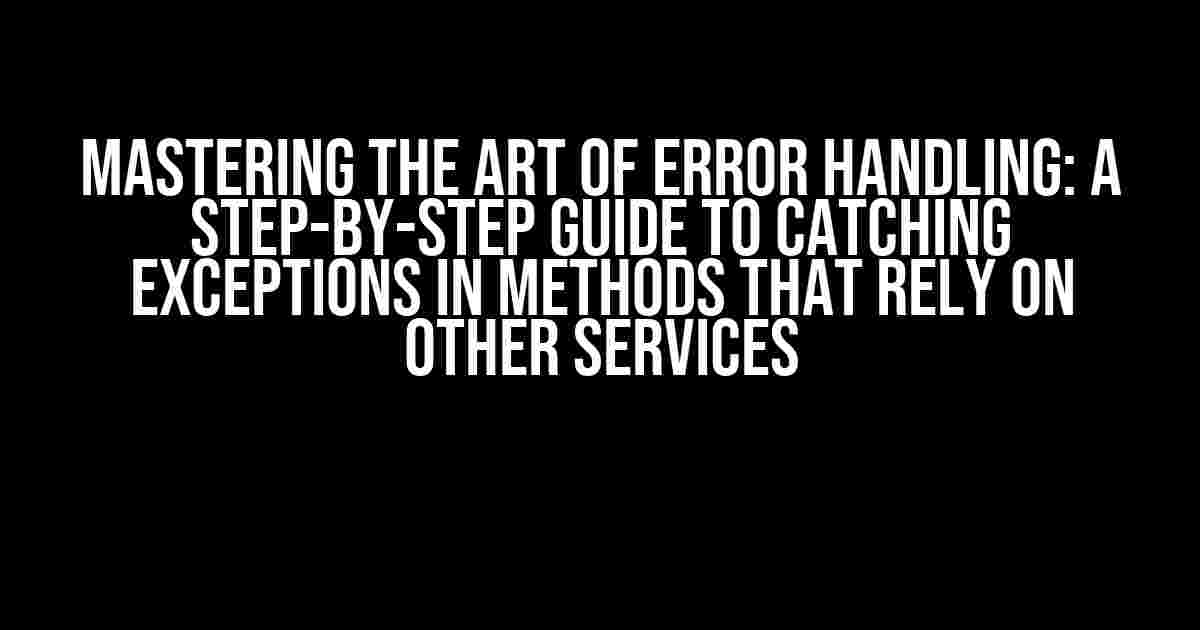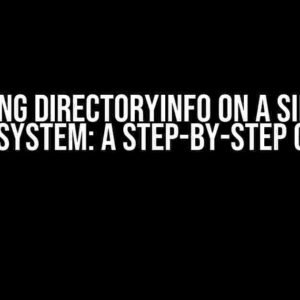As a developer, you’re no stranger to the concept of services and methods that rely on them. However, have you ever stopped to think about what happens when something goes wrong? When a service fails to respond or returns an unexpected result, your method can come crashing down. That’s where exception handling comes in – a crucial aspect of writing robust and reliable code. In this article, we’ll delve into the world of error handling and explore how to catch exceptions in methods that rely on other services.
Understanding the Problem: Why Error Handling Matters
Imagine you’re building a web application that relies on a third-party payment gateway to process transactions. Your method, `processPayment()`, calls the payment gateway’s API to initiate the transaction. But what if the API returns an error or times out? Without proper error handling, your method will fail, leaving your user high and dry.
The consequences of poor error handling can be severe:
- Data loss or corruption
- System crashes or freezes
- User frustration and loss of trust
- Reputation damage and potential legal issues
The Importance of BOOL Methods
When working with methods that rely on other services, it’s essential to use BOOL methods to indicate success or failure. A BOOL method returns a boolean value (true or false) to signal whether the operation was successful or not.
Consider the following example:
public BOOL processPayment(string paymentDetails) {
// Call the payment gateway API
APIResponse response = paymentGateway.processPayment(paymentDetails);
if (response.isSuccess()) {
return true;
} else {
return false;
}
}
In this example, the `processPayment()` method returns a BOOL value indicating whether the payment was successful or not. This allows the calling code to handle the result accordingly.
Catching Exceptions: The Art of Error Handling
Now that we understand the importance of BOOL methods, let’s dive into the world of exception handling. Exception handling is the process of catching and responding to errors that occur during the execution of your code.
There are two types of exceptions:
- Synchronous exceptions: These occur during the execution of your code, such as divide-by-zero errors or null pointer exceptions.
- Asynchronous exceptions: These occur outside of your code’s execution, such as network timeouts or service unavailability.
Synchronous Exception Handling
When it comes to synchronous exception handling, you can use try-catch blocks to catch and handle exceptions. Here’s an example:
public BOOL processPayment(string paymentDetails) {
try {
APIResponse response = paymentGateway.processPayment(paymentDetails);
if (response.isSuccess()) {
return true;
} else {
return false;
}
} catch (Exception e) {
// Handle the exception
Log.error("Error processing payment: " + e.getMessage());
return false;
}
}
In this example, we use a try-catch block to catch any exceptions that occur during the execution of the `processPayment()` method. If an exception is caught, we log the error and return a BOOL value indicating failure.
Asynchronous Exception Handling
Asynchronous exception handling is a bit more complex, as it involves handling errors that occur outside of your code’s execution. This can include:
- Network timeouts
- Service unavailability
- API rate limiting
To handle asynchronous exceptions, you can use callback functions or asynchronous programming techniques like futures and promises. Here’s an example using a callback function:
public void processPayment(string paymentDetails, callback errorCallback) {
paymentGateway.processPayment(paymentDetails, new APIResponseHandler() {
public void onSuccess(APIResponse response) {
// Handle the successful response
errorCallback(null);
}
public void onError(APIResponse response) {
// Handle the error response
errorCallback(response.getError());
}
});
}
In this example, we use a callback function to handle the result of the `processPayment()` method. If the payment is successful, we call the callback function with a null error parameter. If an error occurs, we call the callback function with an error parameter containing the error details.
Best Practices for Error Handling
When it comes to error handling, there are some best practices to keep in mind:
- Handle errors at the correct level: Handle errors as close to the source as possible to ensure that the error is handled correctly and efficiently.
- Use meaningful error messages: Provide clear and concise error messages that help the user or developer understand what went wrong.
- Log errors correctly: Log errors in a way that makes sense for your application, such as using a logging framework or error tracking service.
- Test error handling: Test your error handling code to ensure that it works correctly in different scenarios.
- Keep error handling separate from business logic: Keep error handling separate from your business logic to ensure that your code remains clean and maintainable.
Conclusion
In conclusion, catching exceptions in methods that rely on other services is crucial for building robust and reliable applications. By understanding the importance of BOOL methods, catching synchronous and asynchronous exceptions, and following best practices for error handling, you can ensure that your code is error-free and provides a great user experience.
Remember, error handling is not just about catching exceptions – it’s about providing a safety net for your users and ensuring that your application remains stable and reliable, even in the face of unexpected errors.
| Error Handling Best Practices | Description |
|---|---|
| Handle errors at the correct level | Handle errors as close to the source as possible |
| Use meaningful error messages | Provide clear and concise error messages |
| Log errors correctly | Log errors in a way that makes sense for your application |
| Test error handling | Test error handling code to ensure it works correctly |
| Keep error handling separate from business logic | Keep error handling separate from business logic for clean and maintainable code |
By following these best practices and mastering the art of error handling, you’ll be well on your way to building applications that are reliable, robust, and provide a great user experience.
Frequently Asked Question
Get the scoop on how to catch exceptions when a method returns a BOOL relying on another service!
How do I catch exceptions when a method returns a BOOL and relies on another service?
When dealing with a method that returns a BOOL and relies on another service, it’s essential to implement a try-catch block to catch any exceptions that might occur. This way, you can handle errors gracefully and provide a better user experience. For example, in Java, you can use a try-catch block like this: `try { BOOL result = myMethod(); } catch (Exception e) { // handle the exception }`
What kind of exceptions should I catch in this scenario?
When a method returns a BOOL and relies on another service, you should anticipate exceptions such as service unavailability, network timeouts, or data format errors. Catching specific exceptions like `IOException`, `TimeoutException`, or `ServiceUnavailableException` can help you provide more targeted error handling. Additionally, you can catch the general `Exception` class to handle any unexpected errors.
Can I use a fallback mechanism to return a default value when an exception occurs?
Yes, you can implement a fallback mechanism to return a default value when an exception occurs. This approach ensures that your method returns a value even when the reliant service is unavailable. For instance, you can return a default BOOL value or a custom error message. Just be sure to log the exception for further analysis and debugging.
How can I notify the user about the exception and provide a better user experience?
When an exception occurs, it’s crucial to notify the user about the issue and provide a clear error message. You can display a toast message, an alert dialog, or an error page depending on your application’s requirements. Make sure to provide a concise and informative error message that explains the issue and potential next steps.
Are there any best practices for handling exceptions in this scenario?
Yes, some best practices for handling exceptions when a method returns a BOOL and relies on another service include: logging exceptions for debugging, providing clear error messages to the user, implementing fallback mechanisms, and testing your error handling code thoroughly. Additionally, consider implementing circuit breakers or retry mechanisms to handle transient errors and improve the overall resilience of your application.



